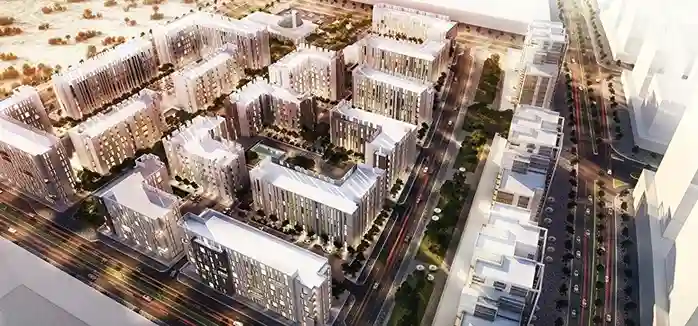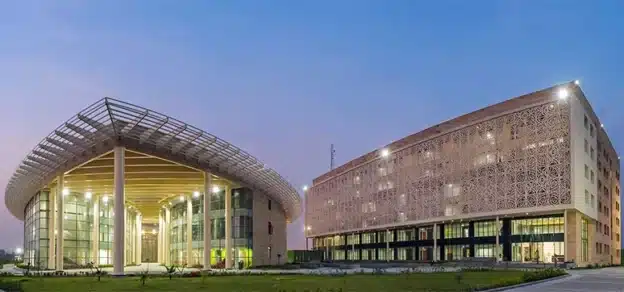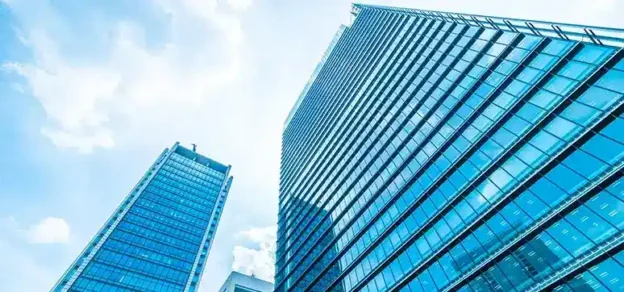Glass is primarily or fundamentally used for seeing through the glass as well as for capturing natural light. Glass is chosen by designers because of its better aesthetics as well as to see through. The goal of fully Highrise buildings became a glittering reality during the era of contemporary architecture and the international style, producing stunning facades, permitting interior and exterior connection, and honouring fantastic vistas.
Apart from adding beauty, it offers several other benefits. The structural load is reduced as a result of the glass’ lightweight. Due to its transparency, it lets in the most natural light possible, which reduces the need for power. Glass that meets the right specifications for reflection and thermal insulation will undoubtedly increase efficiency. Last but not least, glass roofs and facades offer unhindered vistas and contribute to the building envelope being interactive.
However, in the modern era, due to stricter construction codes and more sustainability requirements, it is becoming more and more difficult to carry out this architectural intention. We interviewed a few industry experts and here are the responses presented in this cover story on the current market trends, the key challenges & the major opportunities, and future trends. Read them here:
Demand for Glass in Niche and Low-Rise Applications

Generally, in the Middle East, glass with high visual light transmission, low reflection values, and good thermal performance is preferable for most commercial and residential applications. However, glass requirements shall not be generalised. In my opinion, the glass selection shall always be a project-specific task, based on the project requirements. We should not select glass just because it “looks good”, the glass selection shall be the “right one” for the project, taking into account the sustainability and thermal requirements, says Michelle Bacellar, Technical Director, Meinhardt Façade Technology.

Fadi Massouh, Managing Director, TSSC Glass & Aluminium Works LLC, says more and more consultants are demanding higher light transmissions in their glass selections. What this means is the glass can transmit more light inside the building while still having the required thermal requirements. For glass balustrade applications consultants are also asking for crystal clear options which eliminate the greenish color of normal clear glass. A good example would be the glass balustrades at the FIVE Palm Hotel in Dubai.
Trends in Architectural Glass
According to Michelle, more curved and double-curved glass is being proposed for projects in the Middle East region. This brings up some challenges associated with the selection of an adequate Low-E coating that can simultaneously comply with the project’s thermal requirements and withstand the bending process without damage, especially in externally concave glass applications. In addition, determining a reasonable and acceptable level of visual quality for the fabricated curved glass can also be challenging.
People are generally going for more greyish-to-silver colour selections. In the past, it used to be more bluish, greenish, or even bronze colours. We also see people looking for bigger glass panel sizes with high-performance Low-E coatings, says Fadi. The use of glass has been an important part of architecture and design for its ability to provide optimal transparency and natural light. In recent years, the industry trend has been toward the larger glass and pushing back the framing, uninterrupted lines, multiple zones for varying degrees of privacy, and the flexibility to open up an entire wall all enhance the character of a space. With the right design trends emerging and architects growing more familiar with the material, its future in building design is only going to continue to get better, believes Ahmed El Banawy, Senior Design, Nakheel.

Glass for Windows / Effective Fenestration
Michelle believes that the glass shall be suitable for its application. The specifier must take into account project-specific visual, performance, and durability requirements when selecting the glass. “My choice would be the Emicool SupVision Series from Emirates Glass it has high levels of transparency, clarity, and solar resistance. From the series, I would select the 40/21 which achieves a nice 41% light transmission allowing ample sunlight to reach indoors. At the same time, it offers a 0.21 solar factor which ensures that most of the sun’s rays and heat do not enter the building. This would allow a very comfortable feel inside the residence, says Fadi.
The choice of glass in architecture is a major aspect that can affect the scope, cost, and aesthetic appeal of your building. An understanding of the key aspects of glass design allows architects to realise their vision and create beautiful buildings, especially when shown in their full glory, can be a very soft and subtle material. Yet it is also an extremely strong material, and no other substance is as transparent. In architecture, glass has always allowed light to enter the rooms while keeping out unwanted light and heat, opines Ahmed.
My favourite choice is the high-strength glasses that are almost colourless and transparent, it generally consists of several components: High-quality glass panes are manufactured by melting raw materials such as quartz sand, potash, or soda ash (all igneous minerals) together with limestone or dolomite – to name but some – at temperatures over 1400 degrees Celsius, he adds.
Specifications and Norms for Glazing

In Dubai, the minimum requirements for the glazing performance are specified in the “Dubai Building Code”. However, often projects will have more stringent requirements in order to comply with a particular green building certification, says Michelle. In Dubai and Abu Dhabi, the main goal of glazing is to reflect the heat to the outside of the building while in Europe it is tailored for keeping the heat inside the building. Therefore glass products in the UAE are completely different from those in Europe. In Dubai glazing U-values should at least be less than 2.1, the Shading Coefficient should be less than or equal to 0.4 and the light transmittance should be more than or equal to 40%. If the glazing area of the building exceeds 40 the above requirements become more stringent, observes Fadi.
Key Elements in Glazing Specifications
• Glass Visible Transmittance: this value specifies which kind of sunlight can penetrate the glass. Glass with a high TVIS-GLASS value allows more UV and IR light to pass through the window.
• U-Value: This number reveals how well the glass insulates. If the U-factor is high, the window is not very efficient, while a lower U-Value denotes that heat does not pass through the glass easily.
• Shading Coefficient: this value indicates how much of the light that hits the window turns into heat. A 0 in this place means no matter how much sunlight hits the window, it will not cause an increase in temperature on the other side of the glass.
• In the UAE, most buildings are required to achieve a shading coefficient of 0.25 if the area of glazing is more than 60%, a U-value of 1.7, and light transmittance of 25%. This has resulted in maximising the usage of high-performance glazing. Double silver-coated Low-E glass makeups have become a norm in local specifications with a shift towards higher performance rated triple silver low-E coated products as well as high-performance coatings
– Ahmed El Banawy, Senior Design, Nakheel
Limitations of having Complete Glass Walls on Buildings

Michelle notes, in Dubai, buildings with over 60% glazed area will need to comply with more stringent thermal performances. Glass with high thermal performance will generally have lower visible light transmission, or alternatively, high-performance coatings can achieve great thermal performance while maintaining a good level of light transmission, however, these coatings can be costly. So it is important to establish the correct façade budget in the early stages of the design in order to avoid changes at more developed design stages.
Fadi suggests that once the glazing area of a building is more than 60% then the below glazing specifications have to be met:
• The U-value of the glazing should be less than or equal to 1.7
• The Shading Coefficient of the glazing should be less than or equal to 0.25
• The light transmittance should be more than or equal to 25%
• Ahmed summarises the main limitations of using the glazing into the following:
• It is a very costly material and has to be handled with care.
• It requires regular cleaning. In high rises, external cleaning and maintenance can be very challenging
• Glass façades cause a lot of glares if not treated.
• If the glass is not treated, it will absorb heat. This means that it can act as a greenhouse.
• Most glasses are not earthquake-resistant and not suitable for countries that witness frequent earthquakes.
Future Trends in Architectural Glass

“As the glass industry advances and stretches the fabrication limits, we are seeing a lot more curved and double-curved insulated glass being used in the external façades. I would like to see more photovoltaic glass being used in building façades”, says Michelle. Fadi sees a great future for solar panels that can be built into glass in the coming years. Providing tremendous clean energy to power the buildings of the future. Ahmed says switchable glass is a smart way to create a greater sense of privacy in public spaces and offices, without sacrificing natural light.
The technology allows you to change the transparency of the glass from completely transparent to completely opaque. It is a smooth, seamless transition, so you can’t see it happening. Switchable privacy glass is suitable for both domestic and commercial buildings and has been used for everything from creating shower cubicles in bathrooms to creating space dividers in offices. Digital printing in glass, advances in printing and imaging technology have seen a growth in the use of customised imagery being digitally printed onto glass windows and partitions. Public spaces especially are using technology to bring nature indoors, support visual merchandising, recreate historic scenes or define the atmosphere of a venue.

Solar smart glass offers unrivalled control of solar glare and has been shown to reduce the thermal transmittance through a glass façade which directly cuts down on associated HVAC costs. It can be manually or automatically “tuned” to precisely control the amount of light, glare, and heat passing through a window Semi-transparent photovoltaic devices have a distinct quality that allows their use as an advanced glazing technology. When integrated as a glazing surface, such devices can provide a passive function of reducing solar radiation penetration into the building, and at the same time, generate a considerable amount of energy. This particular property can be used in public or office buildings or any other architectural typologies where vital glazing is needed for building façades.
Performance of Glass in Acoustic Insulation
Michelle says that glass acoustic performance can be greatly improved by the use of laminated glass, sometimes with multiple plies and acoustic interlayers. Glass as a material is a very good sound conductor, but to make it efficient a double glazing layer is required to reach at least a 36dB of insulation. Where there is heavy traffic noise or near airports and metro stations, adding an acoustic layer to the glass panel is recommended which can significantly impact the glass’s acoustic performance which may reach up to 45 dB or more, suggests Fadi.
Ahmed says glass conducts sound very well. A single pane of glass or untreated glazing will do little to prevent noise from entering your home, when put to use, a sheet of laminated glass is far more effective at stopping sound waves than a standard glass of the same size because sound waves have more difficulty travelling through the combination of glass sheets and a PVB interlayer. This is why laminated glass is commonly used as a type of soundproof glass.
The most common glass thicknesses used in soundproof windows and framed glass doors are combinations of 4mm, 5mm, and 6mm panes. Rubber gaskets are detrimental to providing a hermetic seal to the window or door assembly in order to avoid air leakage, and therefore transmission of sound through air. The acoustic insulation performance of glass can be affected by as much as 10 to 15 dB. For 4 mm monolithic glass, the critical frequency is 3 000 Hz, whilst for 13 mm thick plaster it is 3 200 Hz. By increasing the thickness of the glass, its coincidence resonance is displaced toward the lower frequencies.\

It is important not to select a glass with a very high light transmittance as it will have a glare effect. Selecting a moderate light transmittance requirement for residential houses is always advisable. On the other hand, it is highly recommended for storefronts and retail areas have crystal clear glass to showcase the products for sale more clearly for customers, says Fadi. Ahmed observes, in architecture, glare can be a problem from the windows of an office building or the glass on a lot of cars. Glare on the windshield can make it nearly impossible to read the speedometer at night. A double pane of glazing or louvers helps to reduce this effect by reducing the amount of light that is able to enter through the window.
There is also the Anti-glare glass which has a matte finish on the exterior surface, this finish can be either shiny (light) or dull (dark). It is created by applying a thin layer of transparent material to the surface of the glass. This material can be any number of things including thin metal alloys, coatings, paints, and anodised aluminium. When installed in buildings, this type of glass helps reduce glare from sunlight and artificial light.
With regards to the noise; as mentioned before, the thickness of the glass is important as it determines how resistant your window glass is towards the noise. The thicker the glass, the more resistant and shock resistant it will be. Furthermore, the glass can be laminated with a tough plastic that is both transparent in nature and shatter-resistant. Finally, to control the heat; we should use high-performance solar glazing on windows, with coatings that are “spectrally selective”, which means they keep the sun’s heat outside but let daylight in. There’s also photochromic glazing, which changes transparency depending on the intensity of the light (like some sunglasses), and thermochromic glazing, which becomes darker when it is hot, which can also help. Even thermochromic paints, which absorb light and heat when it’s cold, and reflect it when it’s hot, are being developed.
Considerations to be Given When Proposing High Acoustic Performance Glass

• Weight of glass especially when used in an operable frame application, acoustic glass can be very heavy and the designer must ensure the smooth operation of the system proposed
• Interlayer design limitations in terms of temperature, durability, and warranties provided

• Acoustic losses through the frame must be considered, we note that often the supporting frame will not achieve the same acoustic rating as the glass
• Cost
– Michelle Bacellar, Technical Director, Meinhardt Façade Technology
Methods to Manage Glare, Noise, and Heat in the Buildings
• Glare: Direct glare is not generally considered much of a problem as people will not purposely look directly into the sunlight, however, reflected glare can cause great discomfort. Reflected glare can be managed by:
• Decreasing the glass visible light transmittance, however, will also reduce the amount of natural daylight in the building
• Controlling the reflectivity of internal finishes, by selecting matte and rough finishes.
• Noise: Generally, high-frequency sounds can be controlled by using a glass assembly with different glass thicknesses and by changing one or more glass lites from single-ply glazing to double-ply laminated glazing using an acoustic interlayer.
Low-frequency sounds will require more mass, for example increasing the glass ply thickness, for improved performance.
• Heat: A glass’ thermal performance can be improved by using high-performance glazing such as an Insulated Glazing Unit (IGU) with low-emissivity (Low-E) coating.
Michelle Bacellar, Technical Director, Meinhardt Façade Technology
Impact of Types of Glazing on Energy Conservation & Methods to Select the Right Type of Glazing

Michelle says glass selection can have a huge impact on the building’s thermal performance. The glass performance requirements about the glass visual light transmittance, solar heat gain coefficient, and U values shall be established early in the design process in coordination with the project MEP and sustainability consultants. “With regards to energy conservation, I recommend, architects always choose low U-value glasses to save on energy costs for the buildings. If the glass performance doesn’t meet the U-value requirement there are easy solutions such as increasing the gap between the glass panes or adding argon gas”, says Fadi.

Architects should also consider having a suitable amount of light entering the building depending on the building’s purpose, but many studies show that not having enough sunlight in buildings will dramatically impact the residents negatively. Studies also have shown that adding skylights to malls significantly increases shopping performance for malls. Finally, depending on the project location the acoustic requirements should also be taken into consideration, he adds.
The use of glass in architecture is nothing new. However, improvements in glass processing technology have made it possible to render specific and effective solutions for a wide range of architectural projects. In fact, there are so many options available that it’s almost necessary to research different products and their properties, and how this will impact the entire building structure. The Architect must select the most suitable method for that particular project or building. What works great on one building may be a complete disaster on another building, observes Ahmed.
Role of Glass & Glazing Technologies to Increase Efficiency of Building Systems
Glass, when specified correctly, can provide a great amount of natural light to the buildings while providing the required thermal performance for the specific application (for example, keeping the heat out in the Middle East or keeping the heat in within cold climates), notes Michelle. According to Fadi, the introduction of technologies that incorporate solar panels within the glass will have a tremendous impact on the energy efficiency of the building. Also choosing high-performance glazing that minimises the heat transfer to the building will have a high impact on the efficiency and the electricity bill of the building.

Ahmed opines that there are a few systems and technologies to be applied in the glazing system to increase the efficiency of building systems and achieve maximum energy conservation Double-glazed windows, and buildings with good insulation can reduce their energy consumption as a consequence of lower losses in cooling or heating system,
According to the latest reports, 47% of heat losses from building envelope occurs in windows. This is because of the higher overall heat transfer coefficients (U-value) of windows compared to the other components of the building envelope. Double-glazed windows as a specific multilayer glazing technology can be an ideal solution to overcome the abovementioned challenges. The use of double-glazed windows can play a vital role in enhancing the energy efficiency of lighting.

Glass with solar film coating, Using of daylight instead of the artificial lighting system, the lighting instruments are liable for 20% to 35% of total electrical energy expenditure in buildings in hot regions. For the purpose of power saving, sunlight can be used as an alternative lighting source for supplying sufficient luminance intensity levels in buildings.
This can be done during office hours, i.e. from 8.30 am to 5.00 pm, in the façade design of modern buildings, daylight utilisation can reduce more than 25% of total power consumption for lighting. The use of window glass with solar film coating can reduce energy requirements in both cooling and lighting equipment while maintaining the apparent pleasure of residents.

Glass with heat reflective coating, the effect of energy saving is not very efficient as the normal insulation. Nowadays, the use of reflective coating for building insulation is one effective method to improve buildings’ energy efficiency. By reflecting more light, the reflective coating can minimise the heat gained by the building through solar radiation, hence can effectively lower the load required for air conditioning, especially during the hot season.
The shading system, and shading control are essential for ensuring thermal comfort for the building interior. The passive shading method is efficient for curtailing heat acquired by building walls. One obvious disadvantage of passive shading is that it acts as a barrier that limits the availability of sunlight. This limits the use of natural daylight by the building which can provide energy savings.
Aside from conventional shading systems, nowadays solar panels can be used as a standard method for shading as well. Ultimately the energy gained from the shading is influenced by the climatic conditions of desired building area. Double skin façade system, Double skin façade systems (DSF) is generally applied to gain better energy efficiency from the building façade, it is constructed by an offset of exterior glazing which comes from interior glazing attached to the curtain wall.

Actually, it is a controllable shading system positioned between the cavity of external and internal glazing systems, DSF achieved more acceptance because of its transparent properties which allow deep connection with buildings’ surroundings. It also admits to entering a huge amount of sunlight inside the building boundary without any glitter.
Conclusion
Glass is currently the most cutting-edge and complex construction material thanks to advancements in production and refining technologies. Today, it can nearly entirely satisfy both practical and aesthetic needs, making it the material of choice for many architects. Due to the advancement of insulated glazing and energy-efficient glass, it has increasingly been used in modern design, especially in Western nations because of how well it performs in those climates. Glass is now used for a variety of purposes besides just windows, including letting in natural light, shielding from rain, wind, and cold, providing transparency or translucency, supplying fresh air, heating, shielding against sound and solar energy, providing personal and fire protection, withstanding bullets, walling, etc. These features, along with the façade system, have given architects the opportunity to design glass façades with a contemporary and intriguing look.














